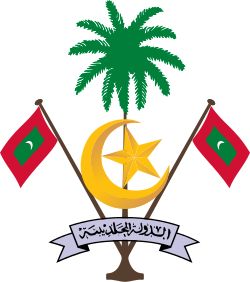| Emblem of the Maldives | |
|---|---|
 | |
| Armiger | Republic of Maldives |
| Shield | A star and crescent or atop a coconut palm proper |
| Supporters | The National Flag of Maldives on either side |
| Motto | الدولة المحلديبية "State of the Mahal Dibiyat" |
The National Emblem of the Maldives [1] consists of a coconut palm, a crescent, and two criss-crossing National Flags with the traditional Title of the State.
